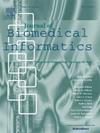Unsupervised discovery of clinical disease signatures using probabilistic independence
IF 4.5
2区 医学
Q2 COMPUTER SCIENCE, INTERDISCIPLINARY APPLICATIONS
引用次数: 0
Abstract
Objective
This study uses probabilistic independence to disentangle patient-specific sources of disease and their signatures in Electronic Health Record (EHR) data.
Materials and Methods
We model a disease source as an unobserved root node in the causal graph of observed EHR variables (laboratory test results, medication exposures, billing codes, and demographics), and a signature as the set of downstream effects that a given source has on those observed variables. We used probabilistic independence to infer 2000 sources and their signatures from 9195 variables in cross-sectional training instances sampled at random times from 269,099 longitudinal patient records. We evaluated the learned sources by using them to infer and explain the causes of benign vs. malignant pulmonary nodules in 13,252 records, comparing the inferred causes to an external reference list and other medical literature. We compared models trained by three different algorithms and used corresponding models trained directly from the observed variables as baselines.
Results
The model recovered 92% of malignant and 30% of benign causes in the reference standard. Of the top 20 inferred causes of malignancy, 14 were not listed in the reference standard, but had supporting evidence in the literature, as did 11 of the top 20 inferred causes of benign nodules. The model decomposed listed malignant causes by an average factor of 5.5 and benign causes by 4.1, with most stratifying by disease course or treatment regimen. Predictive accuracy of causal predictive models trained on source expressions (Random Forest AUC 0.788) was similar to (p = 0.058) their associational baselines (0.738).
Discussion
Most of the unrecovered causes were due to the rarity of the condition or lack of sufficient detail in the input data. Surprisingly, the causal model found many patients with apparently undiagnosed cancer as the source of the malignant nodules. Causal model AUC also suggests that some sources remained undiscovered in this cohort.
Conclusion
These promising results demonstrate the potential of using probabilistic independence to disentangle complex clinical signatures from noisy, asynchronous, and incomplete EHR data that represent the confluence of multiple simultaneous conditions, and to identify patient-specific causes that support precise treatment decisions.

使用概率独立性的临床疾病特征的无监督发现
目的利用概率独立性分析电子健康记录(EHR)数据中患者特异性疾病来源及其特征。材料和方法我们将疾病来源建模为观察到的EHR变量(实验室测试结果、药物暴露、账单代码和人口统计)因果图中未观察到的根节点,并将签名建模为给定来源对这些观察到的变量的下游效应集。我们使用概率独立性从630,000个横断面训练实例中随机抽样的9195个变量中推断出2000个来源及其特征,这些样本来自269,099个纵向患者记录。我们通过对13,252份记录中良性与恶性肺结节的病因进行推断和解释,并将推断出的病因与外部参考文献和其他医学文献进行比较,从而对所学资源进行评估。我们比较了三种不同算法训练的模型,并使用从观测变量直接训练的相应模型作为基线。结果该模型对参考标准中恶性病因的回收率为92%,良性病因的回收率为30%。在推断出的前20种恶性肿瘤病因中,有14种没有在参考标准中列出,但在文献中有支持证据,在推断出的前20种良性结节病因中有11种。模型分解后的恶性病因平均因子为5.5,良性病因平均因子为4.1,多数按病程或治疗方案分层。基于源表达式(Random Forest AUC 0.788)训练的因果预测模型的预测精度与其关联基线(0.738)相似(p = 0.058)。大多数未恢复的原因是由于情况罕见或输入数据中缺乏足够的细节。令人惊讶的是,因果模型发现许多患者显然未确诊的癌症是恶性结节的来源。因果模型AUC还表明,在该队列中仍有一些来源未被发现。这些有希望的结果表明,使用概率独立性可以从嘈杂、异步和不完整的EHR数据中分离出复杂的临床特征,这些数据代表了多个同时发生的情况,并可以确定患者特定的原因,从而支持精确的治疗决策。
本文章由计算机程序翻译,如有差异,请以英文原文为准。
求助全文
约1分钟内获得全文
求助全文
来源期刊

Journal of Biomedical Informatics
医学-计算机:跨学科应用
CiteScore
8.90
自引率
6.70%
发文量
243
审稿时长
32 days
期刊介绍:
The Journal of Biomedical Informatics reflects a commitment to high-quality original research papers, reviews, and commentaries in the area of biomedical informatics methodology. Although we publish articles motivated by applications in the biomedical sciences (for example, clinical medicine, health care, population health, and translational bioinformatics), the journal emphasizes reports of new methodologies and techniques that have general applicability and that form the basis for the evolving science of biomedical informatics. Articles on medical devices; evaluations of implemented systems (including clinical trials of information technologies); or papers that provide insight into a biological process, a specific disease, or treatment options would generally be more suitable for publication in other venues. Papers on applications of signal processing and image analysis are often more suitable for biomedical engineering journals or other informatics journals, although we do publish papers that emphasize the information management and knowledge representation/modeling issues that arise in the storage and use of biological signals and images. System descriptions are welcome if they illustrate and substantiate the underlying methodology that is the principal focus of the report and an effort is made to address the generalizability and/or range of application of that methodology. Note also that, given the international nature of JBI, papers that deal with specific languages other than English, or with country-specific health systems or approaches, are acceptable for JBI only if they offer generalizable lessons that are relevant to the broad JBI readership, regardless of their country, language, culture, or health system.
 求助内容:
求助内容: 应助结果提醒方式:
应助结果提醒方式:


